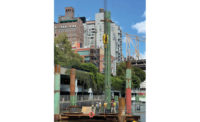“If you build it, they will come” isn’t just a version of a famous film line. For ENR Top 400 listed contractors navigating markets bogged down by supply shortages and delays, it’s strategy. Whether “they” refers to more craft workers, better material lead times or decreased cost risk depends on a firm’s most pressing problems, but contractors overwhelmingly agree that relationship building is a way forward despite the industry’s steadily strained supply chain.
Related Links:
List of the ENR 2022 Top 400 Firms
Firms Extend ACE Mentor Links to Expand AEC Talent Pool
ENR Top 400 Contractors List and Analysis (PDF)
(Requires Subscription)
As firms enter a busy construction year, abuzz with preconstruction planning and anticipation for projects funded by the Infrastructure Investment and Jobs Act (IIJA), Top 400 contractors report that their biggest challenges stem from trying to control what seemingly is uncontrollable.
Pricing volatility, tariffs on building materials, such as lumber and steel, and supply chain disruptions caused by COVID-19 shutdowns and the war in Ukraine all fall under that category. The wide-reaching effects of these challenges are boosting demand in some markets while reducing it in others.
Overall, total revenue for the Top 400 firms rose to a record $421 billion in 2021, a 1.49% improvement over the year before—marking the 11th straight year of increases. Despite slowed revenue growth in the pandemic’s first year, 0.12% from 2019 to 2020, firm revenue increased by 1.62% since the pandemic began.
“Coming out of the pandemic, we thought there would be some normalcy,” says Abrar Sheriff, president and CEO of Turner Construction Co.’s international arm, Turner International. But as international issues continue to impact domestic supply chains, “It’s almost like déjà vu dealing with this,” he adds.
Through its supply chain management service SourceBlue, Turner Construction has been able to use its international relationships in China and Europe to improve project predictability domestically and get materials to jobsites in a timely manner, says Sheriff. The company is ranked No. 1 on the Top 400 list for the second consecutive year.
“We are leveraging our long-term relationships with our manufacturers and suppliers,” says Sheriff. “We feel if we can do that, we can commit to predictability on schedule and cost for our clients and not leave it open-ended.”
With industry’s current challenges of rising costs and shortages, a larger question looms from owners, says Mario Azar, incoming chair and CEO of Black & Veatch. “Are there creative and collaborative solutions that will enable projects to go forward?” he asks. In the last year, Azar says the company has seen examples where, by the completion of final negotiations, projects no longer made financial sense to move forward, for one or both parties.

“[Owners] know about the challenges, so they’ve been engaging us early in their projects, asking us to serve in an advising role.”
Mike Thompson, VP, Robins & Morton
“Materials that used to have widespread availability and clear delivery schedules became more expensive, delivery times stretched and supply chain costs ballooned—creating a fundamental tension between project owners and service providers,” says Azar.
For this reason, he says, working with clients to balance risk, increase flexibility and create a collaborative environment continues to be a major industry challenge.
Industry-wide issues such as inflation, a residential building boom, natural disasters and international conflict can also be sector specific in their impact on markets such as manufacturing, semiconductors and agriculture, explains Mike Thompson, vice president of operational planning and support at Robins & Morton.
“These factors, paired with inflation, contribute to significant overall cost escalation,” says Thompson. “The most common request we receive from owners is still speed to market. [Owners] know about the challenges, so they’ve been engaging us early in their projects, asking us to serve in an advising role. That allows us to develop creative strategies for project delivery.” Those creative strategies are often customized for the project.
“They often involve intently studying the project, understanding the client’s operational goals and tapping our extensive network of trade contractors and vendors for the most accurate up-to-date lead times,” he adds.
Robert Shelton, president of Peinado Construction, says “relationships are more important in this business than they have ever been” to help contractors understand the constantly changing market and minimize exposure to rising costs.
“We’re trying to quantify the exposure and risk profiles for ourselves and for our clients, and manage risk throughout the entire process,” he says. “Our clients look to us to help them and their partners navigate the current and ever-changing market conditions.”







Post a comment to this article
Report Abusive Comment